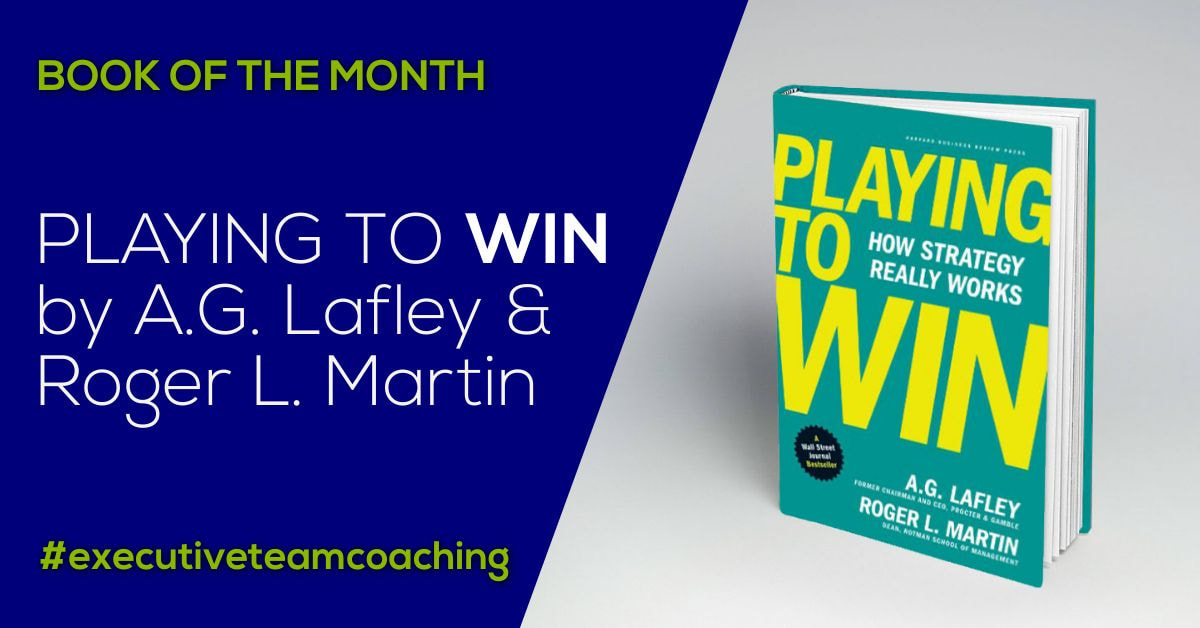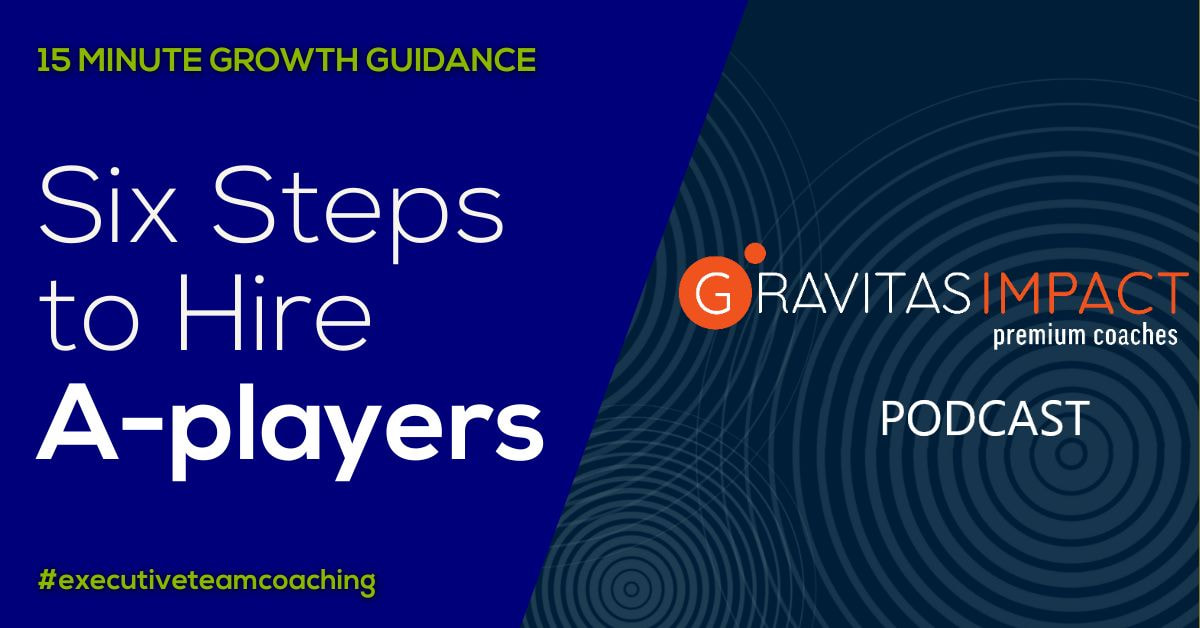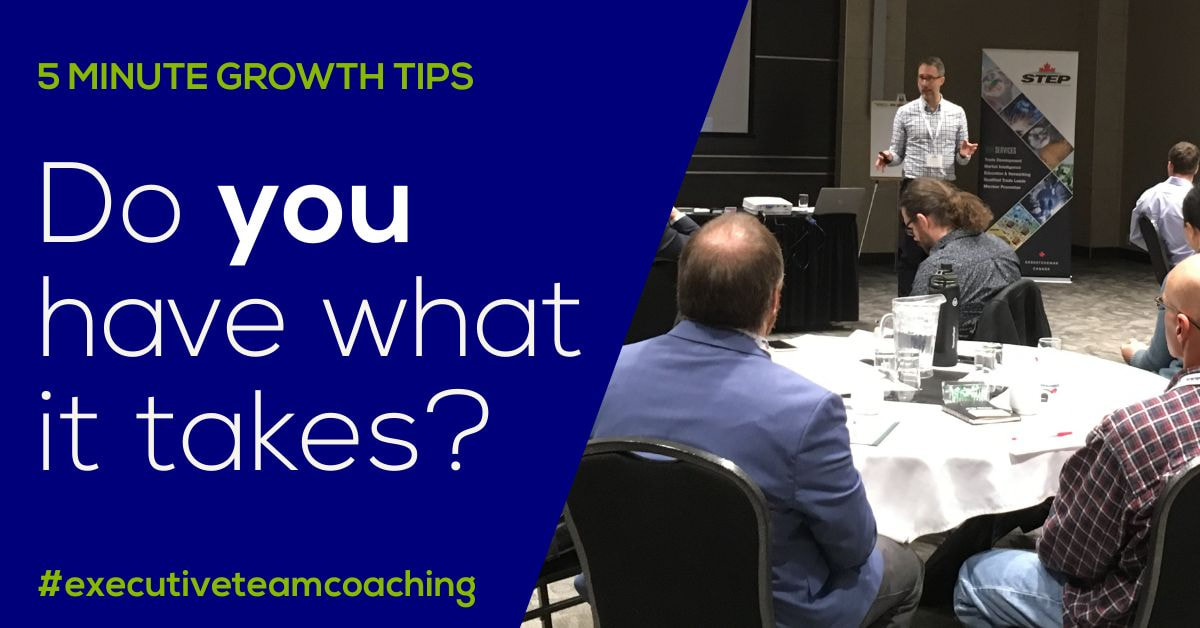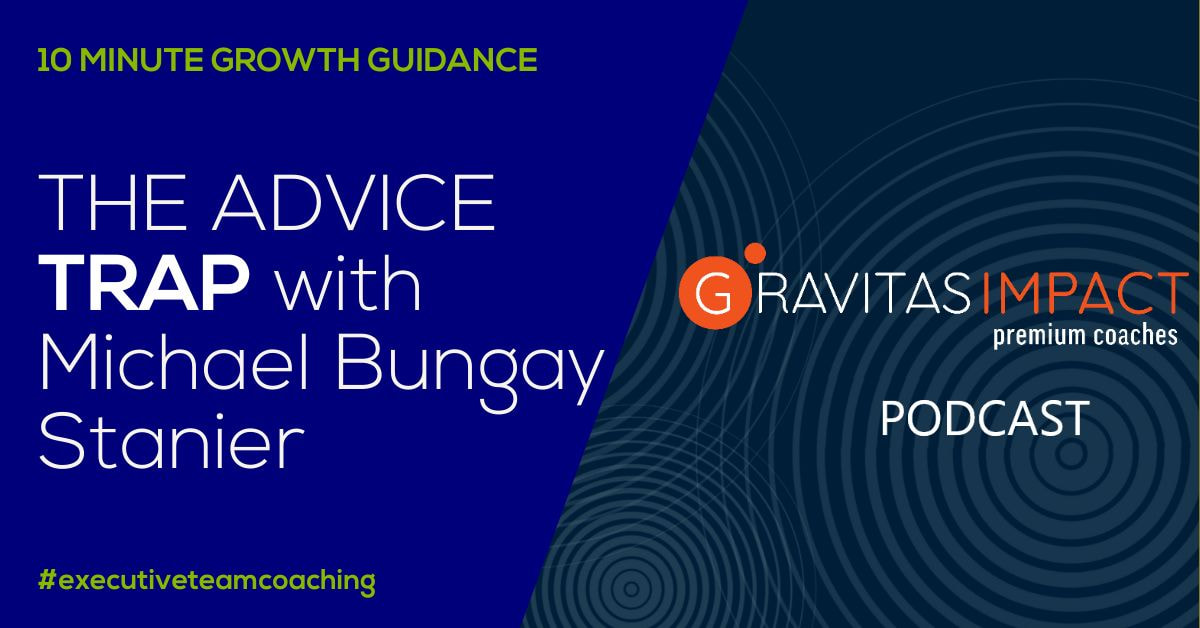|
Why is it that some leaders can be counted on in critical situations and others can’t? What are the key characteristics of these A-players and what makes them different from their peers? In working with CEOs and business owners, this is one of the early conversations we have: “Who are your A-players and how can you tell they’re performing at that level? And what are the behaviors to look for and cultivate in your other leaders to get them to that same level (or decide to part ways)?” In this Gravitas Impact Premium Coaches recorded webinar, Liz Wiseman, author of Multipliers, discusses her key findings on these questions in her new best-selling book Impact Players. Based on a study of 170 top contributors, Wiseman identifies the mindsets that prevent otherwise smart, capable people from contributing to their full potential and the five practices that differentiate Impact Players: • While others do their job, Impact Players figure out the real job to be done. • While others wait for direction, Impact Players step up and lead. • While others escalate problems, Impact Players move things across the finish line. • While others attempt to minimize change, Impact Players are learning and adapting to change. • While others add to the load, Impact Players make heavy demands feel lighter. Wiseman makes clear that these practices—and the right mindset—can help any employee contribute at their fullest and shows leaders how they can raise the level of play for everyone on the team. How can you develop Impact Players in your company?
To find out how to develop A-player talent to grow more easily, quickly and profitability, AND enjoy the ride, try our complimentary Agile Growth Checklist. This self-service questionnaire takes 5 to 10 minutes to complete. You'll receive the checklist with your responses immediately. Within 24 hours, you'll receive a compiled report highlighting areas to improve. Complete section 2 to check your talent processes. Or complete all 7 sections to find out how your company is doing in each of the 7 areas needed to produce more rapid, profitable and sustainable growth. This report is complementary and involves no obligation. Underpinning the Scaling Up system and 7 Attributes of Agile Growth framework I use with my clients are methods developed by many great business thought leaders.
One of these methods is the Where to Play choices in A.G.Lafley and Roger L. Martin’s 2013 book Playing To Win: How Strategy Really Works. The book draws on their experience working together on the strategy transformation of Proctor & Gamble from 2000 to 2009, and distills strategy down to its essence so it’s useful and effective for any size company. They underline first that strategy is about choices. Making trade-offs to focus a company on the higher opportunities for success, rather than spreading a company thin. Their strategy framework includes choosing: 1) how you define winning, 2) where you will play in the market, 3) how you’ll win/compete, 4) what capabilities must be in place and 5) what management systems are needed. Playing to Win helps make better sense of strategic terms like vision, target market, value proposition, core competencies, etc., and helps tie it all together in a logical way. However, it offers few practical tools or specific processes. And some of the long P&G stories seem to miss the point. That said, it’s a great book for those who’ve been exposed to strategic thinking tools and want to deepen their understanding. Book: 272 pgs, 7h9m audio. How can you develop a winning strategy? To find out how you can strengthen your strategy and grow more easily, quickly and profitability, AND enjoy the ride, try our complimentary Agile Growth Checklist. This self-service questionnaire takes 5 to 10 minutes to complete. You'll receive the checklist with your responses immediately. Within 24 hours, you'll receive a compiled report highlighting areas to improve. Complete sections 3 and 6 to check your competitive strategy. Or complete all 7 sections to find out how your company is doing in each of the areas needed to produce more rapid, profitable and sustainable growth. This report is complementary and involves no obligation. As Jim Collins outlined in the book Good To Great, we know that great companies start with having great people. And yet, finding and selecting great people remains elusive to many growing companies, their CEOs and leaders. In our work with these folks, we recommend the Top Grading process to drastically increase the odds of hiring A-players, which we define as being both highly productive and a great fit with our values. In this Gravitas Impact Premium Coaches podcast, Michelle LaVallee, Gravitas Impact Alumni and Topgrading Champion, who has conducted over a thousand Topgrading Interviews across multiple industries worldwide, shares the top 6 ways in which to increase your chances of hiring an A-Player and decrease the risk of hiring other candidates. During this Topgrading overview, Michelle reviews best practices that include:
Subscribe to Gravitas Impact podcast: Android
How can you improve the people element in your company? To find out how to get your people right to grow more easily, quickly and profitability, AND enjoy the ride, try our complimentary Agile Growth Checklist. This self-service questionnaire takes 5 to 10 minutes to complete. You'll receive the checklist with your responses immediately. Within 24 hours, you'll receive a compiled report highlighting areas to improve. Complete section 2 to check your people processes. Or complete all 7 sections to find out how your company is doing in each of the 7 areas needed to produce more rapid, profitable and sustainable growth. This report is complementary and involves no obligation. If you’ve been following this 5 Minute Growth Tips article series, you are now clearer on:
But you may be thinking, I’ve never worked with a coach before, let alone a leadership team coach. It sounds helpful, but also intense. So you may be wondering, can I do it? What’s going to be involved? And am I willing to do the work? These are all important questions to ask yourself before you engage a coach. Over my 17 years working with CEOs and business owners, and their leadership, management and executive teams, I’ve seen CEOs make some common mistakes and I’ve also seen some of the attributes of CEOs who get the most return from leadership team coaching. The CEOs who really crush it and get the highest and fastest return on investment of time, energy and effort, are the one who are: - Willing to invest - Curious and open learners - Team players - Courageous Willing to invest Certainly, there’s a significant financial investment to engaging a leadership team coach. Make no bones about it. The bad news is that the money is the least expensive part of it. Beyond the money, the bigger investment is going to be you and your leadership team’s commitment and follow through to do the hard work of making and acting on decisions. So, the money is part of it. But equally, maybe even more important, is the commitment and effort you put into it to see things through. A good leadership team coach is going to push you, and you need to make sure you’re ready for that. The good news is, if you decide to go down that path, and you decide to work with a leadership team coach, a good one will be with you every step of the way, leading you through the tough choices ahead to get clarity and focus to get your company on the path you want. I’m emphasizing the time commitment because a good leadership team coach is going to pull your whole leadership team together for one or more days at a time through the course of the year. What our clients tell us is they get a great return on that time. Because everyone walks out of the room more focused, there’s more clarity and crisper execution, and you actually get that time back and more. But you and your team have to get through the initial process of getting some foundational best practices put in place. And you’re not going to realize that time gain immediately. And it would be a shame if you gave up early. Also, through all the planning and execution you and your leadership team will do, the changes and improvements you make to the business, in order to grow, are going to take investments as well. Certainly there will be time investment. And you and your team will get that time through the efficiencies I mentioned above. But there will also be financial investments, as I’m sure you can appreciate: in systems, equipment, facilities, people, etc. And, as we know, sometimes they’ll be harder to swallow than others. Some will be “stepped investments”, where your profitability might take a short term hit to get to the profitability you want “tomorrow”. Curious and open learners We’ve found that the CEOs and business owners who get the best results working with leadership team coaches are open to learning and following a proven process, which any good leadership coach will use. A good leadership team coach will also share observations and feedback with the CEO from time to time. And the CEOs and business owners that are open to that feedback, willing to look at themselves, and commit to personal development, are the ones who become better leaders and see their peoples’ performance improve, as well as the company’s. Team players Similar to the notion of openness, you’ll need to be comfortable collaborating with your leadership team coach and be willing to work collaboratively with your leadership team. A good leadership team coach will facilitate key leadership team meetings, namely annual and quarterly planning sessions and potentially monthly check-in meetings. Their facilitation role will allow you to be fully present as a participant in the discussion, and not have to also play the role of meeting facilitator, which rarely works very well. Having a dedicated facilitator, who also teaches and coaches the team, enables the team AND the CEO to bring their best ideas and greatest condor to the conversation to achieve more clarity, focus and alignment. This works the best when the CEO takes a truly collaborative stance, rather than a directive one, with their team. For you, this may feel like letting go of control. In a way, it’s like putting your CEO role on pause for the day as you participate in the conversations. Of course, a good leadership team coach shouldn’t leave you out of the loop about what they’re going to lead you and your team through in your meetings. They should be consulting with you on what to cover and what needs discussing. But you’ll need to be receptive to what they recommend. So, rather than giving them direction, you’ll need to work collaboratively, sharing with them what is happening, and being curious and open to their suggestions for what to work on next. Courageous We also find CEOs get great results if they are willing to do everything it takes to apply what they learn, make decisions, execute, and grow. This includes holding people accountable by insisting that their people learn from their mistakes, having tough conversations with team members when needed and removing people who ultimately aren’t a fit. It also includes CEOs having the courage to hold themselves accountable for their part and to be vulnerable with their team on the journey. You need roughly 80% of all this for the relationship to work well and for you and your leadership team to make real progress and get real results. So, one should ask themselves, out of these four attributes, what will be easiest for me? And, what will be most difficult and why? Knowing what area will be more of a struggle for you, a good leadership team coach will challenge you to grow in that area. This is what it takes to get great results assuming you’re working with a good leadership team coach. So, how do you choose a good one? What should you look for? And how do you choose one who’s right for you? I’ll cover that in my next 5 Minute Growth Tip article. How can you be successful growing a thriving company? To find out how to get things right to grow more easily, quickly and profitability, AND enjoy the ride, try our complimentary Agile Growth Checklist. This self-service questionnaire takes 5 to 10 minutes to complete. You'll receive the checklist with your responses immediately. Within 24 hours, you'll receive a compiled report highlighting areas to improve. Find out how your company is doing in each of the 7 areas needed to produce more rapid, profitable and sustainable growth. This report is complementary and involves no obligation. At the core of growing a thriving company is growing the people within it. In fact, one of the main constraints to growth is new and existing leaders, managers and employees not learning fast enough to get the work done right to delight customers and keep them coming back. However, in our work with CEOs and their leadership teams, we often find that they struggle with how to coach their people to learn and grow. One of the most common mistakes is being the chief problem solver. They solve the problems employees bring them and therefore encourage employees to not think for themselves or grow their skills and abilities. This also causes employees to lack confidence and be less engaged, productive and effective. Ultimately, it also exhausts the leader and prevents them from working on the business. In this Gravitas Impact Premium Coaches podcast, Michael Bungay Stanier, best-selling author of the Coaching Habit shares the key points from his latest book, The Advice Trap, to help CEOs, owners and leaders grow their people to grow their companies by addressing their own urge to give advice. Subscribe to Gravitas Impact podcast: Android
How can you improve people development in your company? To find out how to develop people to grow more easily, quickly and profitability, AND enjoy the ride, try our complimentary Agile Growth Checklist. This self-service questionnaire takes 5 to 10 minutes to complete. You'll receive the checklist with your responses immediately. Within 24 hours, you'll receive a compiled report highlighting areas to improve. Complete section 2 to check your talent development processes. Or complete all 7 sections to find out how your company is doing in each of the 7 areas needed to produce more rapid, profitable and sustainable growth. This report is complementary and involves no obligation. |
Archives
December 2029
Categories
All
|






 RSS Feed
RSS Feed
